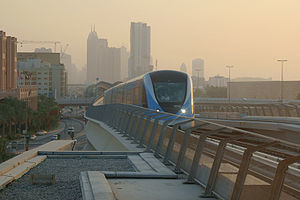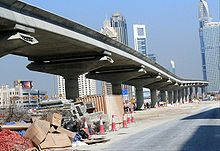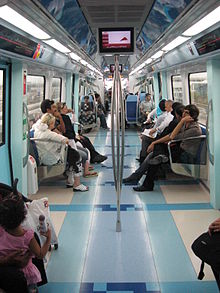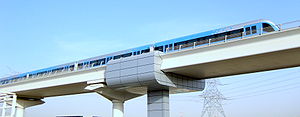- Dubai Metro
-
Dubai Metro
مترو دبي
Info Locale Dubai, United Arab Emirates Transit type Rapid transit Number of lines 2 complete
0 under construction
3 proposedNumber of stations 43 open, 4 not open Operation Began operation September 9, 2009 Operator(s) Serco/Roads & Transport Authority Technical Track gauge 1435 mm Electrification Third rail, 750 V DC[1] The Dubai Metro (in Arabic: مترو دبي) is a driverless, fully automated metro network in the United Arab Emirates city of Dubai. The Red Line and Green Line are operational, with three further lines are planned. These first two lines run underground in the city centre and on elevated viaducts elsewhere (Elevated railway).[2] All trains and stations are air conditioned with platform edge doors to make this possible.
The first section of the Red Line, covering 10 stations, was ceremonially inaugurated at 9:09:09 PM on September 9, 2009, by Mohammed bin Rashid Al Maktoum, Ruler of Dubai,[3] with the line opening to the public at 6 AM on September 10.[4] The Dubai Metro is the first urban train network in the Arabian Peninsula.[5] More than 110,000 people, which is nearly 10 per cent of Dubai’s population, used the Metro in its first two days of operation.[6] The Dubai Metro carried 10 million passengers from launch on 9 September 2009 to 9 February 2010 with 11 stations operational on the Red Line.[7]
At 75 km, the Dubai Metro is frequently cited as the world's longest fully automated metro network.[8]
Contents
Construction
Planning of the Dubai Metro began under the directive of Dubai's ruler Sheikh Mohammed bin Rashid Al Maktoum who expected other projects to attract 15 million visitors to Dubai by 2010. The combination of a rapidly growing population (expected to reach 3 million by 2017) and severe traffic congestion necessitated the building of an urban rail system to provide additional public transportation capacity, relieve motor traffic, and provide infrastructure for additional development.
In May 2005, a AED 12.45 billion/US$ 3.4 billion design and build contract was awarded to the Dubai Rail Link (DURL) consortium made up of Japanese companies including Mitsubishi Heavy Industries, Mitsubishi Corporation, Obayashi Corporation, Kajima Corporation and Turkish firm Yapı Merkezi.[9] The first phase (worth AED 15.5 billion/US$ 4.2 billion) covers 35 kilometres (22 mi) of the proposed network, including the Red Line between Al Rashidiya and the Jebel Ali Free Zone set for completion by September 2009[10] and the Green Line from Al Qusais 2 to Al Jaddaf 1. This was to be completed by June 2010.[11] A second phase contract was subsequently signed in July 2006 and includes extensions to the initial routes. The Red Line partially opened at 9 minutes and 9 seconds past 9 PM on September 9, 2009 (9/9/9 9:9:9), inaugurated by Sheikh Mohammed bin Rashid al Maktoum.[12]
Construction Cost Increase
The construction cost of the Dubai Metro project has shot up by about 80 per cent from the original AED 15.5 billion/US$ 4.2 billion to AED 28 billion/US$ 7.6 billion.[13] The authorities contradicted this, saying that the cost of the project did not overshoot. They attributed the increase in expenditure to the major changes in the scope and design of the project. The authorities also expect to generate AED 18 billion/US$ 4.9 billion in income over the next 10 years; but they speculate that the Metro would not be a profit-making enterprise, since the fares would be subsidised.
Construction Delays
Work officially commenced on the construction of the metro on March 21, 2006.[14] In February 2009, a top RTA Rail Agency official said the $ 4.2 billion Dubai Metro project would be completed on schedule despite global crisis.[15] However only 10 out of 29 metro stations of the red line opened on 9 September 2009.[11]
Construction of the 18 stations on the red line and another 18 on the green line restarted on 7 February 2010, according to contractors, after a settlement was reached with a Japanese-led consortium over disputed payments of about $ 2 billion-$ 3 billion. Construction of all 29 metro stations on the Red Line was declared complete on April 28, 2010 by the acting chief of the RTA Rail Agency.[16]
Seven more stations on the Dubai Metro Red Line opened on 30 April 2010. Ten new trains were pressed into service, giving a total of 22 trains in service when the stations opened. The seven stations are, Emirates Station, Airport Terminal 1 Station, Dubai Internet City (TECOM) Station, Al Karama Station, Emirates Towers Station, Marina Station and Ibn Battuta Station. In addition to this, a further three stations were opened on 15 May 2010; Al Quoz Station, GGICO Station and World Trade Center Station. Furthermore, Business Bay Station, First Gulf Bank (Burj Al Arab/Gold and Diamond Park) Station, Sharaf DG (Al Barsha) Station, Nakheel (Emirates Golf Club) Station and Jumeirah Lake Towers Station were opened on October 15, 2010. After much delay, Jebel Ali Station, the terminus of the Red Line on the Abu Dhabi side was opened on March 11, 2011,[17] whilst the remaining stations on the Red Line will be opened by the end of the first half of 2012.[18] No date has been set for the opening of the final two stations on the Green Line.
Operation
The Dubai Metro is operated by Serco under contract to the Dubai Roads & Transport Authority.[19]
Before launch, Dubai Municipality Public Transport Department expected the metro to carry 1.2 million passengers on an average day, 27,000 passengers per hour for each line, and 355 million passengers per year once both lines are fully operational. It is planned provide transport for 12% of all trips in Dubai. After the first month of operation (on a limited network), the actual monthly ridership was 1,740,578, which equates to under 60,000 passengers/day.[20] After the opening of more stations in May 2010, ridership surged to 103,002 passengers/day and reached 130,000/day by the beginning of October 2010, though still short of the originally anticipated 140,000 passengers/day.,[21] ridership is expected to rise to 170,000/day by the end of 2010. When the Green Line opened on September 9, 2011, ridership on the Red Line was noted as 180,000/day, with the new line expected to add as much as 120,000/day to the network.
One issue for the new system will be how to reliably and comfortably get riders to their final destination if it is not located at a metro station. The RTA has changed and added "feeder bus routes" which act as shuttle services to and from major locations in and around the station area. There are bus and taxi laybys constructed as well as drop off zones at each station for ease of passenger access. [22]
In addition 268 km of light rail lines are also planned, these will serve as feeders to the Dubai Metro. The Al Sufouh Tramway is one of the light rail plans.[22]
Lines
The first two lines of the Dubai Metro will have 70 kilometres (43 mi) of lines, and 47 stations (including nine underground stations).[23]The Roads and Transport Authority's masterplan includes 320 km of metro lines up to 2020 to cater to the expected 3.3 million population of the city. There are plans for 268 km of light rail tracks to act as a feeder system for the Metro. The fate of this entire network – which would reportedly be divided into Yellow, Orange, Magenta and Black lines – is now dependent on an economic recovery and private investment.[24]
Proposed
In 2011, RTA stated that there are no "immediate plans" to build the Blue and Purple lines "in the next five or six years".[25]
- Purple Line: along Al Khail Road.[26] It will have about eight stations on the route, three with check in facilities. However, The Dubai Airports claimed that this was unfeasible as it did not pass through many localities. They however suggested opting for a "central terminal" similar to ones in the US where trains leave from inside the airport to the other airport with trains also leaving to the city. The RTA have taken this into consideration.
- Blue Line: along Emirates Road.[26]
- Yellow Line: Announced in April 2008[22]
- Red Line Extension: 15.5 km and six new stations, terminating at the border with Abu Dhabi. No dates for completion announced.[27]
- Green Line Extension: The line could be further extended by 11 km from Al Jaddaf to International City under the Green Line extension project.[28]
Summary of Complete and Proposed Lines
Line Terminals Original Proposed
Completion DateConstruction Started Opened Length Stations Trip Time [29] Average Speed Cost [30] Cost/Km US$ Red
LineAl Rashidiya -
Jebel AliSept 2009 August 2005 [31] Sept 2009 (10 stations)
April 2010(+19 stations)[32]52.1km
5km underground29
(27 open)68 - 69 minutes 46 km/hr AED28.0b
US$7.6b [13]AED375.3m
US$102.2mGreen Line Al Qusais -
Al JaddafMarch 2010 [22] July 2006 [33] 9 Sep 2011 [34] 22.5km 8km underground 18
(16 open)38 - 39 minutes 35 km/hr Purple Line Dubai International Airport -
Al Maktoum International Airportby 2012 [22] No immediate plans [25] Not Open 49km [22] 8
(0 open) [22]unknown unknown US$2.73bn [25] 55.7m Blue Line Dubai International Airport -
Al Maktoum International Airportby 2011 [35] No immediate plans [25] Not Open 47km [22] 18? unknown unknown unknown unknown Virtual game/tour
The software development company Olive Global has been contracted by the RTA to build a virtual simulation model of the Dubai Metro.[36] This simulation permits the player to choose a character and either play a game where the player attempts to get around the metro system as quickly as possible, or simply tour four metro stations; Jebel Ali Station (42) and Business Bay Station on the Red Line, and Al Nahda Station and Union Station on the Green Line. This virtual simulation is up and running on the RTA website [3].
List of stations
 Khalid bin Al Waleed (BurJuman) Station
Khalid bin Al Waleed (BurJuman) Station
Dubai Metro is composed of at-grade (G) elevated Type 1, Type 2 and Type 3 (T1, T2 and T3, respectively) underground stations (U) and underground transfer station types (UT). Type 1 is the regular at-grade concourse station, Type 2 is a regular elevated concourse station, and Type 3 is an elevated special track station with an extra track to hold a non operational train. Underground transfer stations will be accommodating both the Red and Green lines for easy transfers.
Besides these differences, there are four themes used in the interiors of the stations: earth, water, fire and air. Earth stations have a tan-brown colour effects; water has blue-white colour effects; fire has orange-red colour effects; and the air has green colour effects.[37][38]
- Red Line:[37]
- Rashidiya Station (Depot)
- Emirates Airlines Station
- Airport Terminal 3 Station - For all Emirates Flights
- Airport Terminal 1 Station - For all Non-Emirates Flights
- Al Garhoud Station (GGICO station)
- Deira City Centre Station
- Al Rigga Station
- Union Station (Interchange, connecting with Green Line)
- Khalid bin Al Waleed Station (Interchange, connecting with Green Line)
- Al Karama Station
- Al Jafiliya Station
- World Trade Centre Station
- Emirates Towers Station
- Financial Centre Station
- Burj Khalifa / Dubai Mall Station
- Business Bay Station
- Noor Islamic Bank Station (Al Quoz)
- First Gulf Bank Station
- Mall of the Emirates Station
- Sharaf DG Station
- Dubai Internet City Station
- Nakheel Station
- Dubai Marina Station
- Jumeirah Lake Towers Station
- Nakheel Harbor and Towers Station
- Ibn Battuta Station
- Energy Station
- Jebel Ali Industrial Station
- Jebel Ali / Jafza Station
The main depot for the trains will be at Rashidiya just before the Rashidiya Station, while an auxiliary depot is located at Jebel Ali Port.
- Green Line:[38]
- Etisalat Station (T3)
- Al Qusais 1 Station (T2)
- Dubai Airport Free Zone Station (T2)
- Al Nahda Station (T2)
- Stadium Station (T2)
- Al Quiadah Station (T2)
- Abu Hail Station (T2)
- Abu Baker Al Siddique Station (T2)
- Salah Al Din Station (U)
- Union Station (UT, connecting to Red Line)
- Baniyas Square Station (U)
- Palm Deira Station (U)
- Al Ras Station (U)
- Al Ghubaiba Station (U)
- Saeediya Station (U)
- Khalid Bin Al Waleed Station (UT, connecting to Red Line)
- Oud Metha Station (T2)
- Health Care City Station (T2)
- Al Jedaf 1 Station (T2)
- Creek Station (T2)
The train depot is located at Al Qusais just before the Al Qusais 2 Station.
Corporate branding
Officials are negotiating with international and local companies over naming rights for 23 stations on the two lines. This corporate branding is the first of its kind.[39]
Trains
Japanese manufacturer Kinki Sharyo built a total of 87 five-car trains for the Red and Green lines.[40] They are designed to carry 643 seated and standing passengers, and unusually for a mass transit system, the trains have three classes of accommodation: Gold Class, Women and Children class, and regular Silver Class (economy).[41] The first train was delivered to Dubai in March 2008.[40] The metro has driverless operation and uses third rail current collection. Trained wardens accompany passengers to help with emergencies.[42]
Signaling
To permit fully automated operation, Thales Rail Signalling Solutions is supplying its SelTrac IS communications-based train control and NetTrac central control technology. This is configured for a minimum headway of 90 sec. Maximum speed of the trains will be 90 km/h, giving a round-trip time of 2 h 23 min for the Red Line and 1 h 23 min for the Green Line.
Red Line trains will initially run every 7 minutes off-peak, with a minimum headway of 3 min 45 sec provided during the peaks, when 44 trainsets will be in service. From 2010, when 51 trains will be in service, the line will have a peak-hour capacity of 11,675 passengers per hour in each direction. The theoretical maximum design capacity is 25,720 passengers per hour, which would require 106 trains.
The Green Line will have an initial capacity of 6,395 passengers per hour per direction, with 16 trains in service. The design capacity of this route is put at 13,380 passengers per hour, with 60 trains in service.[43]
Over 280,000 passengers used the Dubai Metro during the first week of its operation.[44]
Incidents and accidents
On the first day of operation, one metro train broke down and the passengers had to wait for two hours for a second train to be picked up.[45]
On 28 February 2010, thousands of commuters were affected after part of Dubai Metro's Red Line was closed after a small fire on the track. A section of the Red Line between Al Jafiliya Station near Za'abeel Park and Terminal 3 Station was shut at around 7pm and remained closed until Monday morning. Trains were evacuated at Khalid Bin Waleed Station, Union Square Station and Al Rigga Station. A Dubai Roads and Transport Authority (RTA) spokesman confirmed there was smoke on the underground track between Union Square and Khalid Bin Waleed Stations. However, RTA officials remained tight-lipped about what had caused the incident.[46][47]
See also
References
- ^ "Specifications: Dubai Metro - Most Advanced Urban Rail Systems - Railway Technology". http://www.railway-technology.com/projects/dubai-metro/specs.html. 090914 railway-technology.com
- ^ Roads & Transport Authority, UAE
- ^ "Dubai Metro Opens On Time But Over Budget". Sky News. 2009-09-09. http://news.sky.com/skynews/Home/World-News/Dubai-Metro-Opens-On-Time-But-Over-Budget-Worlds-Largest-Auto-Driverless-Train-System/Article/200909215377456?lpos=World_News_Second_Home_Page_Feature_Teaser_Region_0&lid=ARTICLE_15377456_Dubai_Metro_Opens_On_Time_But_Over_Budget%3A_Worlds_Largest_Auto_Driverless_Train_System.
- ^ "Dubai metro unlikely to speed business growth". Ameinfo. 2009-09-08. http://www.ameinfo.com/208881.html.
- ^ "Will metro change Dubai car culture?". BBC News. 2009-09-11. http://news.bbc.co.uk/2/hi/middle_east/8247330.stm.
- ^ TheNational.ae
- ^ RTA.ad
- ^ http://gulfnews.com/news/gulf/uae/traffic-transport/dubai-metro-makes-a-mark-1.863978
- ^ Dubai metro contract awarded, Railway Gazette International 2005-07-01, retrieved 2008-03-15
- ^ Dubai RTA - Red Line Project as on 2007-09-09
- ^ a b "Ten key Dubai Metro stations set for launch". Gulf News. 2009-08-30. http://www.gulfnews.com/nation/Traffic_and_Transport/10344684.html.
- ^ "UAE Vice President launches Dubai Metro". Gulf News. 2009-09-09. http://archive.gulfnews.com/indepth/dubaimetro/main_story/10347699.html.
- ^ a b "Changes to Metro put cost up by Dh12bn". The National. 2009-08-31. http://www.thenational.ae/news/uae-news/transport/changes-to-metro-put-cost-up-by-dh12bn.
- ^ Work begins on Dubai Metro project, Khaleej Times 2006-03-22, retrieved 2006-03-22.
- ^ "Dubai Metro on track despite global crisis". Arabian Business. 2009-01-02. http://www.arabianbusiness.com/542506-dubai-metro-on-track-despite-global-crisis---rta-chief. Retrieved 2009-02-06.
- ^ Dubai Metro Red Line now complete
- ^ [1]
- ^ [2]
- ^ Serco preferred bidder for Dubai metro operations contract, Railway Gazette International 2007-07-01, retrieved 2008-03-15
- ^ ArabianBusiness.com
- ^ Metro punctuality record, ridership estimate
- ^ a b c d e f g h "Blue and Purple Lines unlikely in next five years". Railway-Technology.com. http://www.railway-technology.com/projects/dubai-metro/.
- ^ "Shaikh Mohammad tours the Dubai Metro project". Gulf News. 2007-11-08. http://archive.gulfnews.com/articles/07/11/08/10166000.html. Retrieved 2007-12-22.
- ^ Business24-7.ae
- ^ a b c d "Blue and Purple Lines unlikely in next five years". Arabian Supply Chain. 2011-09-11. http://www.arabiansupplychain.com/article-6476-blue-and-purple-lines-unlikely-in-next-five-years/.
- ^ a b Dubain-online.com
- ^ ArabianBusiness.com
- ^ Business24-7.ae
- ^ Train Times and Landmark Flyer, RTA UAE
- ^ Based on exchange rate US$1 = AED3.672
- ^ Red Line, RTA UAE
- ^ Dubai Metro Red Line now complete
- ^ Emirati Law
- ^ "Dubai Metro makes a mark". Gulf News. 2011-09-10. http://gulfnews.com/news/gulf/uae/traffic-transport/dubai-metro-makes-a-mark-1.863978.
- ^ ["Plans for Dubai's third metro track finalised". Gulf News. 2006-05-24. [http://gulfnews.com/news/gulf/uae/traffic-transport/plans-for-dubai-s-third-metro-track-finalised-1.238058.
- ^ RTA commissions Virtual Metro in Dubai
- ^ a b Dubai Rapid Link Consortium - Approved Red Line Project Model dtd. 5 Nov. 2006
- ^ a b Dubai Rapid Link Consortium - Approved Green Line Project Model dtd. 19 Nov. 2006
- ^ "Is Advertising the New Indicator for Emerging Markets?". Contrarian Profits. 2008-08-11. http://www.contrarianprofits.com/articles/is-advertising-the-new-indicator-for-emerging-markets/4474. Retrieved 2008-08-12.
- ^ a b First Dubai metro train arrives, Railway Gazette International 2008-03-14, retrieved 2008-03-15.
- ^ "At a glance:Dubai Metro". Gulf News. 2007-03-19. http://archive.gulfnews.com/indepth/dubaimetro/puffs/mid_left/10112170.html. Retrieved 2008-05-30.
- ^ Trained wardens will help people on Dubai Metro, Khaleej Times 2007-04-16
- ^ Dominic Ellis (2008-03-27). "Driverless trains to support a prosperous future". Railway Gazette International. http://www.railwaygazette.com/news/single-view/view/10/driverless-trains-to-support-a-prosperous-future.html. Retrieved 2008-12-28.
- ^ "World's Longest Automated Unmanned Metro Opens in Dubai". Pravda.ru. 2009-09-24. http://english.pravda.ru/world/asia/23-09-2009/109468-dubai_metro-0. Retrieved 2009-09-23.
- ^ Gulfnews.com
- ^ Fire breaks out on Metro track
- ^ Glitches identified on the Red Line
External links
- Dubai Metro Map
- Roads & Transport Authority Dubai Metro homepage
- Dubai Municipality metro information
- Mydubaimetro.com - unofficial community resource website for Dubai Metro
- Dubai Metro Routemap
- Dubai Metro information website
- Dubai Metro Stations Map
Developments in Dubai Skyscrapers Shopping centres Entertainment Transport Dubai Metro (Red Line • Green Line) • Dubai World Central (Al Maktoum International Airport) • Palm Jumeirah MonorailLand reclamation Other projects List of development projects in Dubai • List of tallest buildings in DubaiCategories:- Proposed buildings and structures in Dubai
- Dubai Metro
- Transport in Dubai
- Underground rapid transit systems
- Serco
Wikimedia Foundation. 2010.








